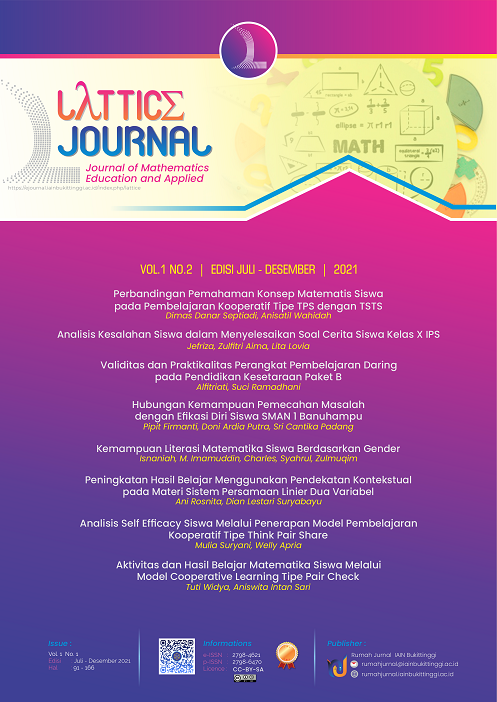Validitas dan Praktikalitas Perangkat Pembelajaran Daring pada Pendidikan Kesetaraan Paket B
DOI:
https://doi.org/10.30983/lattice.v1i2.5057Keywords:
Validitas, Praktikalitas, RMEAbstract
This study aims to determine the validity and practicality of the product developed in the form of a mathematics learning device based on Realistic Mathematical Education (RME) in the flat-sided geometry material for Package B students equivalent to class VIII SMP. This research was conducted at the Kasih Bundo Community Learning Activity Center, Bukittinggi. This research is a development research using the Plomp development model. The results of the research discussed are related to the results of the validity test and practicality test. The validity test is based on the results of the expert review, while the practicality is based on one to one and small group trials in the field. The validity test obtained very valid criteria, while for the one to one and small group activities it was found that there was an increase after using the student worksheet (LKPD) which was developed using the RME approach.
Penelitian ini bertujuan untuk mengetahui validitas dan praktikalitas dari produk yang dikembangkan berupa perangkat pem,belajaran matematika berbasis Realistic Mathematic Education (RME) pada materi bangun ruang sisi datar untuk siswa Paket B setara kelas VIII SMP. Penelitian ini dilakukukan di Pusat Kegiatan Belajar Masyarakat Kasih Bundo Bukittinggi. Penelitian merupakan penelitian pengembangan menggunakan model pengembangan Plomp. Hasil penelitian yang dibahas terkait hasil uji validitas dan uji praktikalitas. Uji validitas berdasarkan hasil expert review sedangkan praktikalitas berdasarkan uji coba one to one dan small group di lapangan. Uji validitas tersebut memperoleh kriteria sangat valid, sedangkan untuk kegiatan one to one dan small group diketahui adanya peningkatan setelah menggunakan lembar kerja peserta didik (LKPD) yang dikembangkan menggunakan pendekatan RME.
References
Bayu, E. P. S. (2017). Perancangan Perangkat Pembelajaran Mata Pelajaran Matematika Paket C Setara SMA. Inovasi Pendidikan, 2(18).
Hardika dan Sutaryat Trisnamansyah: 2010. Model Pembelajaran Fasilitatif Untuk Peningkatan Kreativitas Belajar Program Pendidikan Kesetaraan Paket C .Jurnal Ilmiah VISI PTK-PNF - Vol. 5, No.2, Desember 2010
Lely, Eka. 2019. Pelaksanaan Worshop Analisis Standar Isi Kurikulum 2013 Pendidikan Kesetaraan di Kota Bukittinggi. Hibah Kemenag (Tidak Publikasi)
Mustofa Kamil, (2011), Pendidikan Non Formal, Bandung: Alfabeta.
Nasution, M. N. (2015). Manajemen Mutu Terpadu. Bogor Ghalia Indonesia
Ploomp, T, and Nieveen N. 2013. Education Design Research. Netherland: Kluwer Academic Decelopment (SLO).
Purwananti, Yepi S. 2016. Peningkatan Kualitas Pendidikan Sebagai Pencetak Sumber Daya Manusia Handal. Proceeding International Seminar FoE Vol 1 Mei 2016.
Pramuditya, Surya, dkk. 2018. Desain Game Edukasi berbasis android Pada Materi Logika Matematika. JNPM (Jurnal Nasional Pendidikan Matematika) Vol. 2, No. 2, Hal. 165-179 p-ISSN 2549-8495, e-ISSN 2549-4937
Pribadi, Benny. (2009). Model Desain Sistem Pembelajaran.Jakarta:Dian Rakyat
Sadikin, Hamidah. 2020. Pembelajaran Daring di Tengah Covid-19). Jurnal BIODIK Volume 6 Nomor 02 tahun 2020.
Syaiful Hamzah Nasution. Jurnal Kajian Pembelajaran Matematika Vol. 2 No. 1. Pentingnya Literasi Teknologi Bagi Mahapeserta didik Calon Pendidik Matematika: Universitas Negeri Malang. 2018
Downloads
Submitted
Accepted
Published
Issue
Section
License
Authors who publish with Lattice Journal : Journal of Mathematics Education and Applied agree to the following terms: Authors retain copyright and grant the Lattice Journal : Journal of Mathematics Education and Applied right of first publication with the work simultaneously licensed under a Creative Commons Attribution License (CC BY-SA 4.0) that allows others to share (copy and redistribute the material in any medium or format) and adapt (remix, transform, and build upon the material) the work for any purpose, even commercially with an acknowledgement of the work's authorship and initial publication in Lattice Journal : Journal of Mathematics Education and Applied. Authors are able to enter into separate, additional contractual arrangements for the non-exclusive distribution of the journal's published version of the work (e.g., post it to an institutional repository or publish it in a book), with an acknowledgement of its initial publication in Lattice Journal : Journal of Mathematics Education and Applied. Authors are permitted and encouraged to post their work online (e.g., in institutional repositories or on their website) prior to and during the submission process, as it can lead to productive exchanges, as well as earlier and greater citation of published work (See The Effect of Open Access).









